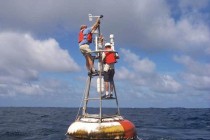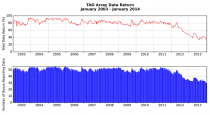February 7th, 2014 by Roy W. Spencer, Ph. D.
I’m seeing a lot of wrangling over the recent (15+ year) pause in global average warming...when did it start, is it a full pause, shouldn’t we be taking the longer view, etc.
These are all interesting exercises, but they miss the most important point: the climate models that governments base policy decisions on have failed miserably.
I’ve updated our comparison of 90 climate models versus observations for global average surface temperatures through 2013, and we still see that >95% of the models have over-forecast the warming trend since 1979, whether we use their own surface temperature dataset (HadCRUT4), or our satellite dataset of lower tropospheric temperatures (UAH):
_thumb.png)
CMIP5-90-models-global-Tsfc-vs-obs-thru-2013 Enlarged
Whether humans are the cause of 100% of the observed warming or not, the conclusion is that global warming isn’t as bad as was predicted. That should have major policy implications...assuming policy is still informed by facts more than emotions and political aspirations.
And if humans are the cause of only, say, 50% of the warming (e.g. our published paper), then there is even less reason to force expensive and prosperity-destroying energy policies down our throats.
I am growing weary of the variety of emotional, misleading, and policy-useless statements like “most warming since the 1950s is human caused” or “97% of climate scientists agree humans are contributing to warming”, neither of which leads to the conclusion we need to substantially increase energy prices and freeze and starve more poor people to death for the greater good.
Yet, that is the direction we are heading.
And even if the extra energy is being stored in the deep ocean (if you have faith in long-term measured warming trends of thousandths or hundredths of a degree), I say “great!”. Because that extra heat is in the form of a tiny temperature change spread throughout an unimaginably large heat sink, which can never have an appreciable effect on future surface climate.
If the deep ocean ends up averaging 4.1 deg. C, rather than 4.0 deg. C, it won’t really matter.
-------------
El Nino monitoring system in failure mode
Nature
An ocean-monitoring system that extends across the tropical Pacific is collapsing, depriving scientists of data on a region that influences global weather and climate trends.

Nearly half of the moored buoys in the Tropical Atmosphere Ocean (TAO) array have failed in the past two years, crippling an early-warning system for the warming and cooling events in the eastern equatorial Pacific, known respectively as El Nino and La Nina. Scientists are now collecting data from just 40% of the array.
“It’s the most important climate phenomenon on the planet, and we have blinded ourselves to it by not maintaining this array,” says Michael McPhaden, a senior scientist at the US National Oceanic and Atmospheric Administration (NOAA) in Seattle, Washington. McPhaden headed the TAO project before it was transferred out of NOAA’s research arm and into the agency’s National Weather Service in 2005.
The network was developed over the course of a decade following the massive El Nino of 1982‒83. NOAA maintains some 55 buoys across the eastern and central Pacific that monitor weather conditions as well as water temperatures down to 500 metres. Working in concert, the Japan Agency for Marine-Earth Science and Technology (JAMSTEC) maintains another dozen buoys in the western tropical Pacific. Combined, the monitoring system has become a cornerstone for seasonal weather forecasting given the tropical Pacific’s influence on broader weather patterns.

The TAO array monitors conditions in the tropical Pacific Ocean. Turquoise dots represent US buoys, while yellow dots show Japanese buoys.
Expand
An array adrift
The array’s troubles began in 2012, when budget cuts pushed NOAA to retire a ship dedicated to performing the annual servicing that keeps the TAO buoys in working order. According to McPhaden, NOAA’s annual budget for the project stood at about US$10 million to $12 million before 2012 - a figure that included around $6 million to cover the dedicated ship. In fiscal year 2013, the agency spent $2 million to $3 million to charter boats for maintenance runs, but McPhaden says that these operations have not been enough to keep the system going. Meanwhile, although JAMSTEC has thus far kept its portion of the array up and running, it too is under budgetary pressure.
A cadre of researchers from around the world will meet next week at the Scripps Institution of Oceanography in La Jolla, California, to discuss possible solutions. NOAA has indicated that the agency will put additional resources into the programme this coming year, but few expect that this will be enough to fully restore the array.
The amount of data returned by the TAO array has plummeted as buoys have gone offline.
“The array really revolutionized our science, and to let it deteriorate is such a waste of the investment the Americans have made over the past 30 years” says Wenju Cai, a climate modeller at the Commonwealth Scientific and Industrial Research Organization in Aspendale, Australia. Cai was the lead author on a recent paper1 with McPhaden and others projecting that global warming could double the frequency of extreme El Nino events - such as those in 1982‒83 and 1997‒98, each of which caused epic damage around the globe. ICECAP COMMENT: Clear nonsense and/or wishful thinking> La Ninas will continue to dominate and El Ninos will be weak and short lived as long as the PDO is cold.
Buoys are not the only instruments monitoring the equatorial Pacific. Scientists also supplement data from the TAO array with measurements of both sea surface temperature collected via satellite and ocean temperature collected by the global network of free-floating buoys known as Argo, which dive and report data every ten days. But satellites cannot see beneath the ocean surface, and Argo floats cannot provide the kind of real-time measurements at specific locations that come from the array of moored buoys.
In addition to supporting climate research, the TAO array also provides basic data for seasonal weather forecasts issued by various government agencies around the world. The impact of the data loss on current predictions remains unclear, in part because the tropical Pacific has been in a neutral state since the buoy system began to fail. But there are signs that seasonal climate models are beginning to suffer from the lack of data, McPhaden says, and it would be a shame if another major El Nino were to arrive while the system is crippled.
“In my opinion, NOAA dropped the ball on an incredible programme for climate research and weather forecasting,"McPhaden says. “And now they are trying to put Humpty Dumpty back together again.”





